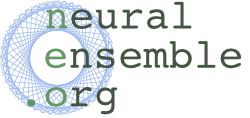CALL FOR CONTRIBUTIONS
Research Topic: "Python in Neuroscience II"
Journal:
co-hosted by Frontiers in Neuroinformatics
and Frontiers in Brain Imaging Methods
URL:
http://www.frontiersin.org/Neuroinformatics/researchtopics/Python_in_Neuroscience_II/1591
Editors:
Andrew P. Davison, CNRS, France
Markus Diesmann, Research Center Juelich, Germany
Marc-Oliver Gewaltig, Ecole Polytechnique Federale de Lausanne, Switzerland
Satrajit S. Ghosh, Massachusetts Institute of Technology, USA
Fernando Perez, University of California at Berkeley, USA
Eilif B. Muller, Blue Brain Project, EPFL, Switzerland
James A. Bednar, The University of Edinburgh, United Kingdom
Bertrand Thirion, Institut National de Recherche en informatique et automatique, France
Yaroslav O. Halchenko, Dartmouth College, USA
Important Dates:
Abstract/outline submission deadline: April 7th, 2013.
Invitations for full paper submissions sent by April 21st, 2013.
Invited full paper submission deadline: July 15, 2013.
Research Topic Abstract
Frontiers in Neuroinformatics hosted the research topic “Python in Neuroscience” in 2008-2009, documenting the first wave of mature
tools to propel Python into common use in the field. This widespread
convergence on Python as the systems integration language of choice in
neuroscience has brought with it exciting new possibilities for
cross-fertilization, collaboration, and interdisciplinary interaction.
The Python ecosystem remains vibrant and inventive, and continues to
produce cutting edge tools for neuroscience research. With this second
research topic on “Python in Neuroscience” we seek to showcase the most
exciting developments since 2009 that include, but are not limited to,
the following themes:
- interactive simulation and visualization
- workflows and automation
- brain-machine interfaces
- advances in neuroimaging analysis methods
- sharing, re-use, storage and databasing of models and data
- data analysis libraries and frameworks
- brain atlasing, ontologies, semantic web
- model description and abstraction languages
We invite contributions that promote innovative use of Python for
scientific work from any branch of neuroscience.
This research topic is dedicated to the memory of Prof. Dr. Rolf
Koetter, visionary, colleague and friend.
Submission Procedure
Researchers and practitioners are invited to submit on or before April
7th, 2013 a max. 1 page abstract/outline of work related to the focus
of the research topic to python.in.neuroscience@gmail.com for
consideration for inclusion as an elaborated full article in the
research topic.
Please include a provisional title, a full author list, and format the
subject of your email as follows: "[python RT] outline - Your Name".
Authors will be notified whether their contribution has been accepted
by April 21st, 2013.
Full Article Information
* Full articles will be solicited based on the abstracts/outlines we
receive by April 7th, 2013.
* The deadline for submission of full articles will be July 15, 2013.
* Manuscripts should be clearly different from user manuals or web
pages. Rather they should focus on the underlying concepts and
innovations in architecture, algorithms, data-structures, workflows,
etc.
* The research topic is co-hosted by Frontiers in Neuroinformatics and
Frontiers in Brain Imaging Methods. Authors choose the journal which
is named when citing their article (Front. Neuroinformatics or Front.
Brain Imaging Methods) by submitting the full article to the
respective journal. All research topic articles will be listed in
the research topic page appearing in both journals.
* Article formatting will be as for standard Frontiers "Original
Research", “Methods” or “Review” articles. Guidelines and instructions
for their preparation can be found here.
* Frontiers in Neuroinformatics and Frontiers in Brain Imaging Methods
are open access journals, following a pay-for-publication model.
Research Topic articles enjoy a generous discount, thanks to the
support of the Frontiers Research Foundation. Details of the
publication fees can be found here.
* Further details will be provided to authors of accepted abstracts by
April 21st, 2013.
Confirmed Submissions
The following authors have been contacted in the preparation phase of
the research topic and have confirmed they would submit a manuscript.
Article titles and author lists are preliminary.
Henrik Lindén*, Espen Hagen*, Szymon Leski, Eivind S. Norheim, Klas H.
Pettersen, Gaute T. Einevoll (*equal contribution), "LFPy: A tool for
simulation of extracellular potentials with biophysically detailed
model neurons".
VK Jirsa, AR McIntosh, et al., "Integrating neuroinformatics tools in
TheVirtualBrain".
Andrew P. Davison, Eilif Muller, Jochen M. Eppler and Mikael Djurfeldt,
"Multisimulations in PyNN: Integrating PyNN and MUSIC".
Robert Pröpper and Klaus Obermayer, "Spyke Viewer: a flexible and
extensible electrophysiological data analysis platform".
Michael Hull and David Willshaw, "morphforge: an object-model for
simulating small networks of biologically detailed neurons in python".
Alexandre Abraham, Fabian Pedregosa, Andreas Muller, Jean Kossaifi,
Alexandre Gramfort, Bertrand Thirion, Gaël Varoquaux, “Statistical
learning for Neuroimaging with scikit-learn”.
A. Gramfort, M. Luessi, E. Larson, D. Engemann, D. Strohmeier, C.
Brodbeck, M. Hamalainen, “MNE-Python: MEG and EEG data analysis with
Python”.
Thomas Vincent, Solveig Badillo, Lotfi Chaari, Christine Bakhous,
Florence Forbes, Philippe Ciuciu, "Flexible multivariate hemodynamics fMRI
data analyses and simulations with PyHRF"
Wiecki, Thomas V. and Sofer, Imri and Frank, Michael J. "HDDM:
Hierarchical Bayesian estimation of the Drift-Diffusion Model in Python”.
M. Djurfeldt, A.P. Davison, J.M. Eppler: "Modeling connectivity: Connection-set Algebra in NEST and PyNN"

No comments:
Post a Comment